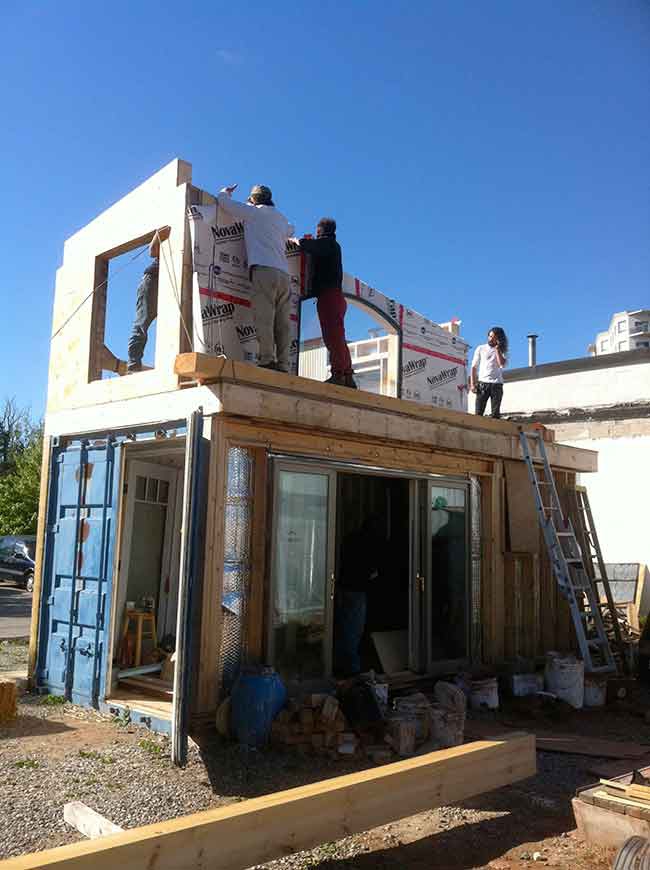
Features
Architectural design
Contracting
Inside the box
Great glazing can turn shipping containers into a home.
February 9, 2016 By Jack Kohane
 Building with shipping containers is the ultimate in recycling, but people still need to end up with liveable space. Glazed containers can provide a foundation for permanent homes, jobsite offices and even portable rental shelters.
Building with shipping containers is the ultimate in recycling, but people still need to end up with liveable space. Glazed containers can provide a foundation for permanent homes, jobsite offices and even portable rental shelters. Living in a steel box might sound Houdiniesque, but crafting a home out of a shipping container can be an escape from the ordinary. “There’s nothing odd about it,” says Christoph Kesting, a Waterloo, Ont.,-based advocate for social justice housing, who believes it’s possible to never buy anything new. “Whatever you want, you can find a used item somewhere. For those thinking environmentally, why not incorporate it into your house? All you need to do is buy a shipping container or three.”
Kesting, 34, president of design/build firm C. Kesting and Associates, claims that the idea of turning a shipping container into a dwelling isn’t new. Around the world, shipping container architecture has been increasingly peppering the landscape. In his travels, Kesting has seen these types of containers being used as housing in Vancouver, and in Geneva, inspiring him to take on a project of his own.
“As the global population increases, we’ll need to find a different way to house inhabitants,” he says. One answer, as he sees it, is Kesting’s Container House, which he’s dubbed the Foxden. According to Kesting, The Foxden demonstrates a lifestyle which is both about simplicity and a sort of natural ergonomics, an imaginative abode which eases neatly into empty suburban lots, infills for city living, and remote landscapes. And for the budget-conscious, a Foxden unit is available for about $48,000 with local delivery and reassembly.
Designed with portability in mind, this container creation (dimensions: 20 feet long, eight feet wide and 8.5 feet tall) can be picked up by standard tilt-and-load trailers. “Delivery time ranges from three to five days,” notes Kesting. And he’s happy to negotiate the completion of the Container House in the buyer’s chosen location with options that fit their lifestyle. “That is, we can bury it, clad it with antique barn-board and trick it out with plumbing within a few weeks,” he points out.
But despite being an edgy-type of dwelling, no one wants to live in a steel coffin. “That’s where glass windows and doors soften the feel of the box,” nods Kesting. “We choose windows with high R-value and glazing, purchased from Dundas Windows and Specialties in Toronto, a fabulous family-team. But just about anything goes here. You can choose to have a traditional door with windows, or sliding glass or French doors for the entire container opening.” Removing metal from containers to install windows and doors can be done in a number of conventional ways, including a plasma cutter, cutting torch, grinder, and even a jig saw for small openings.
Asked how one snags a permit to build a container house, Kesting explains that each municipality is different with its own rules and bylaws. “But as it is with all types of housing, the first best step is get a permit by working with an architect and municipal building department,” he advises. And how much does it cost to buy a shipping container? “I got my 20-foot container for $1,500,” he smiles. To help others who want to live in a box, Kesting has written a free e-book, “9 Critical Steps for Zoning and Building Code Approval,” available through his website, www.howtobuildacontainerhouse.com.
Lucas Griffin agrees there are many benefits to owning a shipping container shelter. “Containers are the strongest self-standing structure in the world, and are built to be stacked, which makes them a natural building block. We sometimes call containers ‘Big Boy Lego,’” chuckles the president of Secure-Rite Mobile Storage, headquartered in Kelowna, B.C. which supplies new, used, or modified shipping containers (and rentals) to customers across Canada. “Container buildings are factory built, so quality control and consistency is a big benefit. And containers are built to be shipped via ship, train, or truck, so they are cost-effective to deploy and deliver to the building. Our new and used steel storage containers are durable, secure and weatherproof, available in lengths of 6, 8, 10, 20, 40, or 45 feet.”
Glass windows and doors installed in Secure-Rite container homes are generally low-E, double-paned glass, while larger openings use structural glass. “We cut out the area of the container where we want the window to go, build a structural steel frame based on our engineered requirements, and install a thermally broken frame with glazing inside the opening,” explains Griffin. “The glazing is secured inside our steel frame by screwing the normal frame into our structural steel frame.” Most of his company’s residential style windows are supplied by PlyGem Windows, while most of his commercial style doors and windows are sourced from Glass Canada. “We use the latest technology in our windows and frames to ensure these installations meet current building code standards,” he adds.
Before buying any containers, one should design how to live in a shipping container, cautions Griffin. “Figure out how much space you want, or really need, and start working up a floor plan. The simplest arrangement of containers is to line them up, but you are really only limited by your imagination and checkbook.” For example, four containers that are 40 feet long and eight feet wide, when set up all side by side, can be re-purposed into a building that’s 40-by-32 feet, a livable 1,280 square feet.
There are now about 30 million steel shipping containers in existence, filled and floating, or sitting empty in a port. Costs of shipping empty containers back to their origin are high, so most times containers are plopped unused in ports. If one lives near a port with abundant containers, then the energy required to transport the steel container to a local building site will be lower than an inland location, far from the port. There are many places to buy containers, and a quick search on the net will turn up an abundance of sites, or search craigslist for containers that are being sold nearby.
Searching for an innovative cottage design, visitors at the recent 2015 Fall Cottage Life show in Toronto didn’t have to look far. Euro Vinyl Windows and Doors, one of Canada’s leading glass suppliers to the burgeoning container home industry, provided the show-stopper with its new container home (one modified for the residential market). The steel home supplied by Giant Container Services, featured full pane windows and modern accents. “We promote it as the perfect for a summer home getaway,” chimes Christopher Meiorin, president of Euro Vinyl from his 30,000-square-foot plant in Woodbridge, Ont. He recommends to anyone who wants to work with a container to keep it simple. “Use the standard dimensions of a 20-by-eight-by-eight-foot (or 40-foot long) container so that they fit on trucks, under bridges and do not require additional building materials to finish. We provide an unfinished shipping container with a glazing package for $20,000 to $25,000 (F.O.B. Toronto). Insulating, adding electrical and finishing can be achieved by most local contractors. The space is small enough that repurposed or recycled building materials can be utilized.”
Laura Weil heads up sales and marketing for Euro Vinyl. She points to the tilt turn window, tilt turn door and sliding door systems as the key window and door types utilized in its shipping container home. “They provide the best sound abatement, physical performance and security when closed and are the most efficient for air infiltration when open,” she says. “We offer fully glazed containers or more common would be partially glazing, depending on the purpose and application. The modern home designs that we apply these same products to are also utilizing a similar glazing specification; typically in a urban centre the front façade will have minimal glazing to maintain a certain level of privacy and home comfort while the rear elevation will be a larger portion of glass to bring in natural daylight in and to capture their private view. This same principal works well in the smaller space too – a balance of glass to wall space is a good design.” The end result is a truly Canadian container design with its bi-parting doors gliding across the face and full tilt turn glazing opening the end wall to bring in a full view.
Weil is getting the message out by using social media, promoting the development of the project via @glasshausliving Instagram and collaborating with fellow ‘instagrammers’ on materials and final finishings. “This suited our needs perfectly as our Glasshaus Living mantra ‘design with daylight’ was perfectly executed. What we look forward to demonstrating just how incredibly quiet this space is too. We have learned a lot about how to effectively insulate and finish the unit.”
Print this page


Leave a Reply